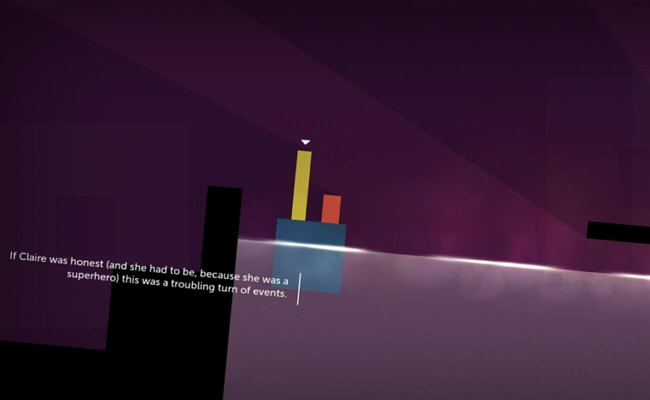Thomas Was Alone looks like a typical platformer. You pick it up, jump around with a few retro-style sprites, and eventually beat the game. But what distinguishes it from all those other games out in the indie market is its distinct narrative tale as you move through the game. Thomas Was Alone mirrors what made Portal so successful: intriguing puzzles shrouded in a simple, but powerful, narrative. You will feel bound to each and every character you encounter in Thomas Was Alone, even as the character count goes into the tens.
The plot of the game is very easy to follow: you play as an AI, and you must move up and to the right. The meaning of up and to the right changes throughout the game, but the objective never does. You travel there with a huge amount of characters—some larger, some smaller, some more or less talented than the average Thomas, but all with the same motive of climbing. Because each character has their own unique set of skills (except poor Chris), you can easily memorize them and switch between them. The only disadvantage of having so many characters is that switching from one to another can take a long time in more populated levels—the levels with Gray, the old block, the Jump Team, and the couple of rectangles is absolutely horrific to navigate through. Accidentally moving the wrong character can spell a lot of extra work. Nonetheless, other than that hiccup of game design, the characters and their mechanics are easy to keep track of.
Interestingly enough, the game has you switch between characters at a crucial moment in time. You learn the mechanics all over again, and this time you can change the character abilities. The plot seems like it’s a sequel, rather than the next chapter of a series, but the same motive remains: climbing up and to the right. And, even though you haven’t invested in these new characters, you still feel motivated to help them. There’s finally a true antagonist in the form of Gray, since the Pixelly Cloud of Death spends most of the game minding her own business and doing her job. The music for the game also helps inspire you as you play, and all of it is very simple, uplifting music. The sound effects are pleasant and emulate old arcade system noises without having a harsh 16-bit edge to them.
There are roughly 100 puzzles in the game—each one carefully thought out in the context of the characters that play them. Although the game shares very little in common with Portal, its difficulty and length are very comparable. If you know what you’re doing, you could breeze through the game very quickly, but if you don’t—well, it might take a while, I’ll put it that way. The graphics are quirky and irreplaceable, and the lighting is absolutely phenomenal. This game is a very good puzzle game, and whether you like the side-scrolling style of Limbo or the 3D approach of Quantum Conundrum, this game will fit well into your collection.


0 Comments